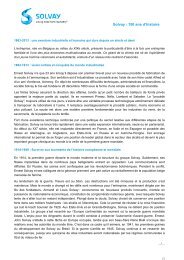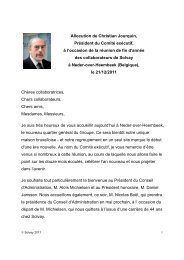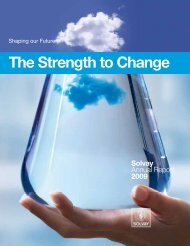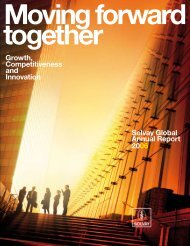THE FUTURE, - Solvay
THE FUTURE, - Solvay
THE FUTURE, - Solvay
You also want an ePaper? Increase the reach of your titles
YUMPU automatically turns print PDFs into web optimized ePapers that Google loves.
14<br />
REPoRt > Innovation elsewhere<br />
“The three ingredients<br />
to successful<br />
innovation: talent,<br />
technology and<br />
tolerance.”<br />
Express portrait<br />
Dr. R.A. Mashelkar is President of the Global<br />
Research Alliance, a network of publicly funded<br />
R&D institutes incorporating over 60 000 scientists,<br />
and Director-General of the Council of Scientifi c<br />
and Industrial Research (CSIR). Deeply<br />
committed to the innovation movement in<br />
India, he is also Chairman of the National<br />
Innovation Foundation, the Reliance<br />
Innovation Council, the Thermax<br />
Innovation Council and the Marico<br />
Innovation Foundation. Honoured by<br />
27 universities in four continents,<br />
in 2005 Dr. Mashelkar was the<br />
fi rst to receive the “Stars of<br />
Asia” award from Business<br />
Week magazine.<br />
innovation in india:<br />
The power to transform<br />
DR. R.A. MASHELKAR, A LEADING ARCHITECT OF INDIA’S SCIENCE<br />
AND TECHNOLOGY POLICIES, DESCRIBES HOW INNOVATION IS<br />
TRANSFORMING <strong>THE</strong> LIVES OF INDIAN PEOPLE.<br />
<strong>Solvay</strong> live – What is your philosophy<br />
on innovation?<br />
Dr. Mashelkar – I am particularly<br />
concerned with looking at how<br />
innovation can be transformational for<br />
society. This is particularly vital in<br />
India. We have super-rich people but<br />
also super-poor. We produce the most<br />
engineers of any country in the world,<br />
yet also the most illiterates. Innovation<br />
must be directed at meeting the needs<br />
of everyone in India.<br />
SL – What are the key<br />
challenges and drivers of<br />
innovation in India?<br />
Dr. M. – Our biggest challenge is<br />
that we are a resource-poor<br />
country. We therefore have to work<br />
hard to get “More From Less”. Another<br />
challenge concerns the three<br />
ingredients to successful innovation:<br />
talent, technology and tolerance. We<br />
have talent in abundance, and are<br />
continuously increasing our<br />
technological capabilities. But we have<br />
to tolerate failure better, by being more<br />
open to take risk. Regarding drivers,<br />
we have top leaders who have<br />
repeatedly proved they can think out of<br />
the box and drive transformational<br />
innovation.<br />
SL – Can you give an example?<br />
Dr. M. – Ratan Tata, Chairman of the<br />
Tata Group, was constantly distressed<br />
to see parents transporting two, three<br />
or more children on the back of their<br />
scooters in the rain. He looked for an<br />
innovative solution. The result is the<br />
Tata Nano car, a radically small and<br />
inexpensive family car. Another<br />
example is the access to education<br />
through an innovative computer-based<br />
literacy programme, developed by F.C.<br />
Kohli and his team, again at Tata. It<br />
costs only $2 per person and enables<br />
an illiterate person to read a<br />
newspaper within six to eight weeks. It<br />
could eliminate global illiteracy within<br />
fi ve years!<br />
SL – How do you defi ne Gandhian<br />
Engineering?<br />
Dr. M. – Gandhi believed in the welfare<br />
of all people, not just an exclusive few.<br />
Similarly, the principle of Gandhian<br />
Engineering is to make science and<br />
technology work for the benefi t of<br />
everyone. It’s about getting “More<br />
From Less For More” – not for more<br />
profi t, but to extend the benefi ts of an<br />
innovation to more and more people.<br />
That, I believe, is the bottom line of<br />
transformational innovation.


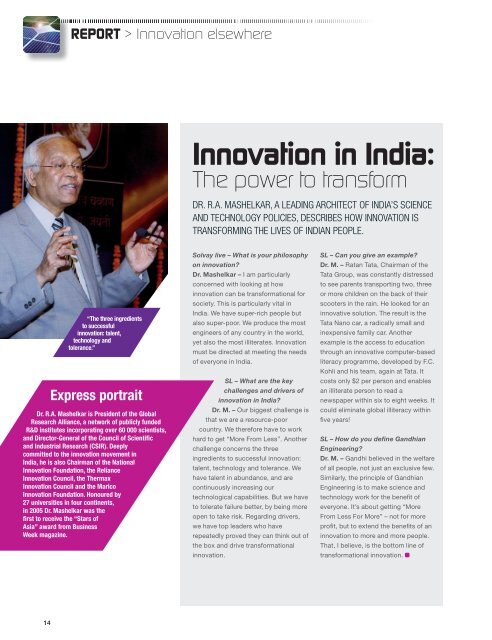

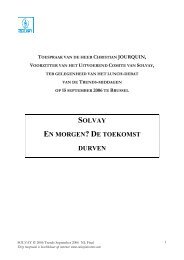
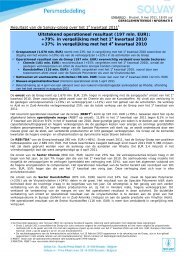

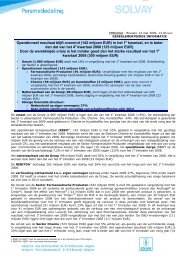
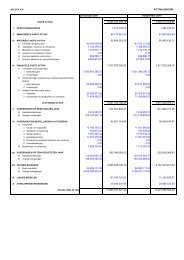

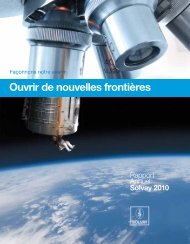
![PROC.1 [LETTRE] - Solvay](https://img.yumpu.com/16585746/1/184x260/proc1-lettre-solvay.jpg?quality=85)
